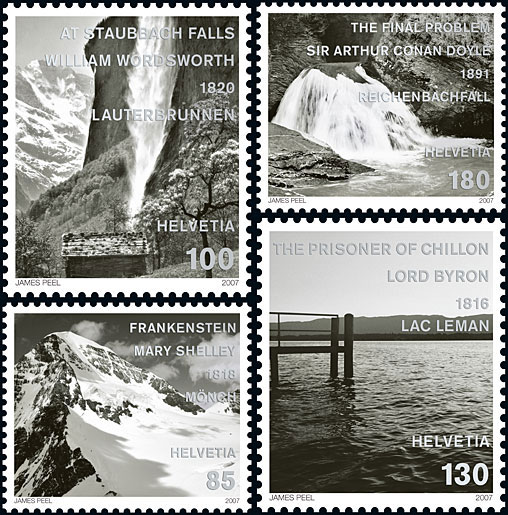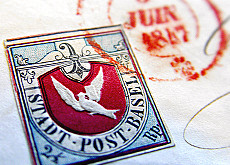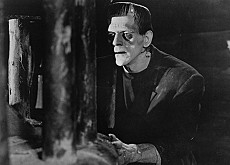Dramatic Swiss landscape inspires stamps

Swiss Post has released four stamps with an English literary connection as part of its series portraying Switzerland through the eyes of foreign artists.
British artist James Peel viewed Switzerland as a location that inspired some of the great works of English Romantic literature and composed four photographs that also reflected the unique seasonal passage of alpine water.
“A lot of my work is around ideas about Romanticism and places, history and memory,” Peel told swissinfo, explaining why he had focused on four 19th-century authors: Mary Shelley, William Wordsworth, Sir Arthur Conan Doyle and Lord Byron.
“When I was living in Switzerland I actually read Shelley’s Frankenstein, so when this job came up, I thought of the incredible natural landscape and how it inspired the idea of the sublime and all the Romantic poets.”
Peel, who now lives in New York but was resident artist at the Laurenz House Foundation in Basel in 2006, says there are two concepts behind the photographs, which he shot in black and white “because I wanted a sense of history”.
“The first idea was of water flowing. Switzerland is a very fluid, liquid place; there’s always a sense of a cycle. I wanted to get that idea across with snow in the mountains going down into a waterfall, then a river, then a lake and then obviously evaporating.
“But there was also the idea of the seasons changing and the fact that you can have two or three seasons at any one time in Switzerland. I actually took the photograph of the snow-capped Mönch in June!”
Challenge
The Swiss Post started the series in 2006 with a French artist, Patrice Killoffer. Next year philatelists will get an Italian artist’s eye view of Switzerland, and in 2009 it will be a German’s turn.
Peel says creating something on such a small scale was quite hard, but he described it as a “fascinating challenge”.
“For an artist a stamp is almost the best thing that you can be asked to do,” he said. “It’s got a purpose, it can be a piece of art and thousands get made. I’ll never again get as much exposure for one piece of work!”
“Shining pyramids”
Mary Shelley wrote the Gothic classic Frankenstein aged 19 when a group of poets, including Lord Byron and her husband Percy Bysshe Shelley, were travelling through Switzerland in 1816.
Shelley chose the dramatic backdrop of the Alps for the encounter between Victor Frankenstein and his monster.
As she wrote in Frankenstein: “The mighty Alps, whose white and shining pyramids and domes towered above all, as belonging to another earth, the habitations of another race of beings.”
English poet William Wordsworth was still a student at Cambridge when he developed a passion for the Alps while reading texts by Geneva philosopher Jean-Jacques Rousseau.
In 1820 he was stirred by the beauty of the Staubbach Falls in Lauterbrunnen, which drop about 300 metres from a hanging valley above the Lütschine River, and devoted a few stanzas to “this bold, this bright, this sky-born, waterfall!”
Elementary
Sir Arthur Conan Doyle had been churning out about two Sherlock Holmes stories a year when in 1893 he and his wife set off on a tour of Switzerland. Frustrated with the character that had taken over his life, he came up with a plan to do away with him.
The Scottish author was so impressed by the Reichenbach Falls that he thought it an ideal place to kill off Holmes – a tourism blessing for the village of Meiringen in the Bernese Alps.
As Conan Doyle wrote in The Final Problem: “It is, indeed, a fearful place. The torrent, swollen by the melting snow, plunges into a tremendous abyss, from which the spray rolls up like the smoke from a burning house.”
Lord Byron’s 392-line narrative poem, The Prisoner of Chillon, was written in 1816 and chronicles the imprisonment of a monk and politician, François Bonivard, in the 16th century.
Byron and Percy Bysshe Shelley were sailing on Lake Geneva (referred to by its French name Lac Leman throughout the poem) and stopped to visit the lakeside 11th-century Château de Chillon – and its dungeon.
Byron was duly inspired. As he wrote in his diary: “How much more, Lake of Beauty! do we feel, in sweetly gliding o’er thy crystal sea.”
swissinfo, Thomas Stephens
The first stamps in Switzerland were issued by cantons Zurich, Geneva and Basel in the 1840s.
The Zurich issue first went on sale in March 1843, making it the second type of stamp in the world after Britain’s Penny Black (1840).
Geneva came out with the Double Geneva in October 1843. It was designed for both local and cantonal mail and only 6,000 were printed.
The popular Basel Dove was issued in 1845. It features a white embossed dove carrying a letter in its beak. It is printed in black, crimson and blue.
The first federal stamps were issued for use across the country in 1850.
In April 2007 a one-franc stamp celebrating the career of Swiss tennis star Roger Federer was issued. Federer became the first living person to receive the honour.
2006 figures
Swiss Post net profit: SFr837 million ($707 million)
Swiss Post employees: 42,178
Swiss Post delivered 2.76 billion letters.
PostMail delivers 15 million letters a day – from greetings cards and love letters to business correspondence, direct marketing letters and newspapers.
PostFinance is a retail financial institution that has a market share of 60%, making it the undisputed leader in the Swiss payments market.
PostBus, a wholly owned subsidiary, has a network covering 12,268 kilometres and carries more than 106 million passengers a year.
There are 2,493 post offices in Switzerland – one of the densest networks in the world.
The philately unit issues about 40 new stamps a year.

In compliance with the JTI standards
More: SWI swissinfo.ch certified by the Journalism Trust Initiative




You can find an overview of ongoing debates with our journalists here. Please join us!
If you want to start a conversation about a topic raised in this article or want to report factual errors, email us at english@swissinfo.ch.